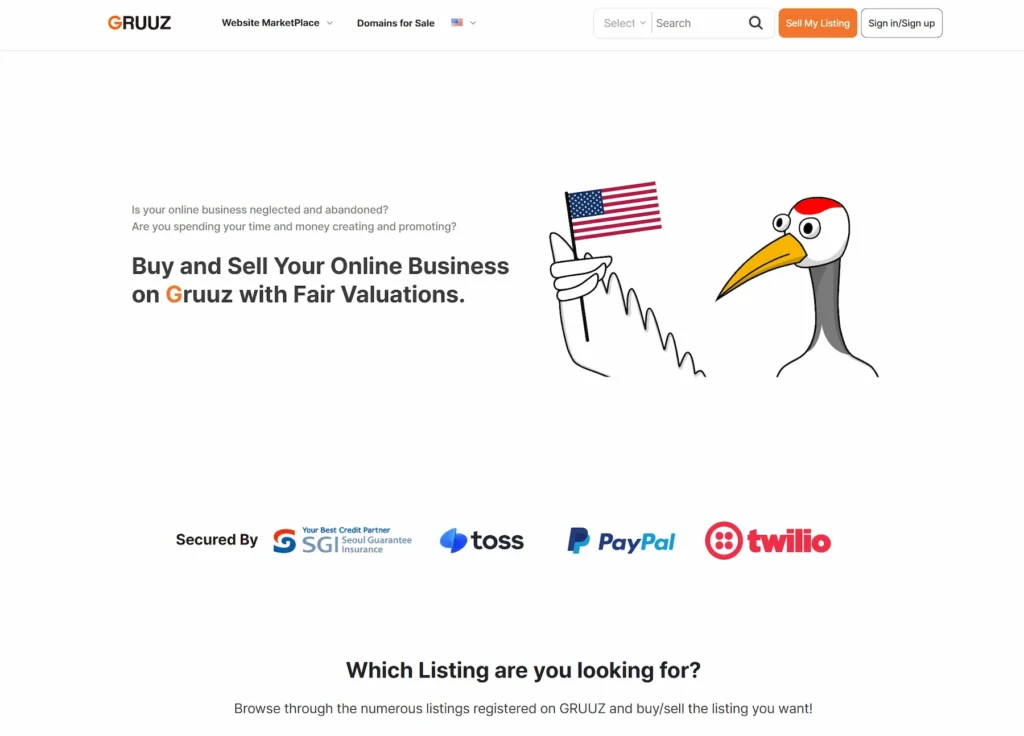eCommerce Businesses for Sale
FAQ
What do you wonder?
Purchasing an eCommerce website allows you to skip the process of setting up the site and the initial stages of marketing and promotion, enabling you to quickly generate revenue and expand the business. Additionally, you can operate more stably based on the established brand and existing customer base.
Providing transparent details on revenue, profit, customer numbers, repeat purchase rates, and revenue models helps build trust with buyers. Additionally, offering financial reports and an overview of operational methods can greatly assist the buyer in making a decision.
The price of an eCommerce website varies depending on factors such as the number of customers, revenue, and profit size, ranging from a few hundred to several million dollars. It’s advisable to compare the site's revenue scale, customer data, and other metrics with your prepared budget to select an appropriate eCommerce website.
eCommerce Businesses for Sale
Remember the days – wandering down the aisles, chatting with shopkeepers, and picking out products? Many of us have fond memories of tagging along with our parents to the market, picking out goods, and making those small but meaningful purchases. It was all so personal, warm, and all-in-all a community driven experience! But today, things are a little different. Now, we want everything fast, easy, and at the click of a button. That's exactly where eCommerce businesses come into play. The pandemic, as we all know, turned the world upside down. COVID-19 didn’t just change how we interacted; it reshaped the way we work, shop, and live. During the pandemic, to minimize direct contact, businesses shifted towards online interactions. Stores adopted contactless selling, companies moved to virtual interviews for hiring, and schools switched to remote learning.

This massive pivot gave the eCommerce industry the push of a lifetime.
As “contactless” became the trending buzzword, the eCommerce market took off like never before. Entrepreneurs—big and small—are increasingly turning to online stores as a way to reach customers without the hassle of a physical location. Even large corporations expanded their online presence, realizing that online shopping was no longer just a convenience, it is now essential.
Buying a website for sale, such as Buying eCommerce businesses seems like a no-brainer. With the growth of eCommerce, there’s no shortage of eCommerce websites for sale. Thanks to smartphones and platforms like Instagram, TikTok, and YouTube, shopping online is as natural as breathing for most people.
I know many of you might be thinking, "What if my online store flops?" or, "Can I even manage an eCommerce business without much experience?" These are perfectly valid questions.
But, you don’t have to go at it alone. One way to solve this dilemma is by purchasing an existing eCommerce website! Instead of building a business from ground up, you can buy one that’s already thriving! The beauty of buying an existing online business is that the hard work is already done for you. The business is already generating revenue, and its operations are often well-established.

It’s a smart way to reduce the risk of failure when starting a new venture.
So, let’s dive into how buying an eCommerce business can be your ticket to success.
What Does Buying an eCommerce Business Mean?
Buying an eCommerce business means purchasing fully functional online store. Whether it’s a small boutique operation or a large, established site, it comes with an existing customer base products and often a team that knows how to keep things running. Think of it as a shortcut to your own business.
Is it Possible to Buy an eCommerce Business?
Absolutely!😆 I’ve personally part of a few deals myself and let me tell you, it’s a lot less intimidating than it seems. Sure, the term “M&A” (mergers and acquisitions) might sound like something out of a corporate drama, but in reality, buying an eCommerce website is simply a way to invest in a business that’s already making money. Whether it’s Shopify store or niche site selling specialty items, the process is manageable and worth exploring.
Where to Find eCommerce Websites for Sale
You might be asking, “Okay, but where do I find these eCommerce businesses for sale?” The most straightforward and secure option is to work with a trusted platform like Gruuz. There are lots of other platforms out there, but I’ve personally found Gruuz to be one of the best for finding quality online businesses up for grabs.
What makes Gruuz so handy is that they vet sellers and provide detailed insights. These platforms offer a range of online businesses for sale, including eCommerce websites, SaaS businesses, and even content-based websites. The beauty of these platforms is that they vet sellers and ensure that businesses are ready for acquisition, which takes a lot of the guesswork out of the process.

Plus, buying eCommerce businesses from such platforms means you have access to detailed information—financials, traffic data, customer demographics—that will help you make an informed decision.
Recommended Buying an eCommerce Business Platforms
When it comes to buying eCommerce businesses, there are several platforms available in the online market, but one that I highly recommend is Gruuz. Gruuz is a marketplace designed to connect buyers and sellers of online businesses.
Why Gruuz Stands Out
Gruuz isn’t just any platform; it’s one of the best for buying and selling eCommerce businesses. Along with their listings, they provide crucial details such as revenue, profits, user numbers, and page views. This transparency allows buyers to evaluate and make confident choices. Gruuz truly focuses on giving buyers the tools they need to make thoughtful, well-rounded purchasing choices.

Is Buying an eCommerce Business Better Than Starting One From Scratch?
There are plenty of reasons why buying an existing eCommerce business rather than starting one from the ground up.
1. Quick Business Start
If you were to start an eCommerce business from scratch, it can feel a little overwhelming. What should you sell? Will you only sell locally, or are you thinking of expanding worldwide? And if you’re selling overseas, how will you ship? These are just some of the many questions you’d need to answer, and the thought of it all can already feel like a mountain to climb.
To get a new online store off the ground, you need to conduct market research, choose a brand name, register a domain that fits the brand, pick a platform (like Shopify or Amazon), design your website, and develop it—this is just the tip of the iceberg. It can be a costly and time-consuming process, with no guarantee of success.
But if you decide to buy an eCommerce business instead, you get to skip all that groundwork. You’re essentially buying a business that has a solid market, a reliable product lineup, an established brand, and a website already in operation.
2. Established Customers and Marketing Channels
I’m sure you’ve heard stories of people who started their own online stores. In the beginning they are filled with hope and excitement. Gradually, they’re disappointed by dropping sales and eventually shut down their businesses. These stories can make anyone wonder, “Will I end up the same way?” It’s a scary thought, especially for those who are new to eCommerce.
If you were to start a business from scratch, you’d need to build your brand, promote your products, and reach potential customers, with no guarantees that your customer base will grow quickly. You’d also have to rely on a lot of trial and error to see what works.
However, if you buy an eCommerce business, you won’t have to worry about all of that. An established online business will have a solid brand presence, a loyal customer base, and a proven sales track record. This means that profitability is already there, giving you a strong foundation to work from.
Plus, businesses with a well-established customer base often have well-built marketing channels, including social media profiles (Instagram, YouTube, etc.) and data from previous campaigns.

These resources can be priceless to you after the acquisition, as they help you reduce the cost of attracting new customers and boost your marketing efficiency.
3. Streamlined Operations
You might be thinking, “Isn’t it enough to just sell products to run an eCommerce store?” Well, partially yes—but it’s not just about selling products. Successful eCommerce management requires much more effort and attention to detail.
First off, securing products is key. If you plan to manufacture the products yourself, you’ll need factories, facilities, and skilled labor. Even if you buy products from suppliers, there’s still a lot of work to be done—like negotiating pricing, managing order volumes, and dealing with suppliers.
Additionally, you’ll need to handle order processing, inventory management, shipping, and customer service. These are all vital components that require time, energy, and expertise to get right.
But when you buy an existing eCommerce business, many of these processes are already in place. You’re acquiring not just the products, but also the infrastructure: manufacturing facilities, supplier contracts, customer service teams, and trained staff. This makes the entire process of running the business smoother and more stable, allowing you to focus on growing the business instead of spending time fixing operational issues.

Plus, the existing team is already familiar with the products and customer service process, which means you won’t have to go through the lengthy process of hiring and training new employees.
Starting a New eCommerce Business vs Buying an Existing eCommerce Business
Elements to look at when buying and selling an e-commerce business for sale
| Compare | Starting a new e-commerce business | Buying an existing eCommerce Business |
|---|---|---|
| Brand | Need to select a brand name and build recognition | Already established brand name and recognition |
| Market Research and Planning | Need to research product and market | All complete |
| Product Supply | Need to secure manufacturing facilities or suppliers | Stable supply of product |
| Operations and Personnel | Need experience in operations and to hire new staff and provide training | Stable operations with existing trained staff |
| Customer and Sales | Need to attract new customers and promote sales | Established customer base and stable sales |
| Marketing channels | Need to define new marketing channels. | Established marketing channel |
| Conclusion | We need some more time to prepare | We can launch immediately! |
Key Factors to Consider When Buying an eCommerce Business
When buying an eCommerce business, there are several critical factors you’ll need to check out. Let’s break it down step by step, using platforms like Gruuz as an example.
1. eCommerce Website Introduction
First, check out how the seller’s describing the website. They’re trying to sell this to you, so they’ll probably paint a pretty picture. Your job? Read between the lines and look for the details that really matter. Here are some things to pay attention to:
1-1. Business Type
What’s the store all about? There’s an incredibly wide variety of products available online. Look at what’s on offer—fashion, electronics, furniture, or even gourmet snacks. Even within categories, there’s a lot of variations. A fashion site might specialize in clothing, shoes, or accessories-and within clothing, it could be men’s women’s or kids’ wear. Knowing what kind of products the store sells will help you determine whether it aligns with your interests and expertise.

If the store has patented products or trendy items, that could be a major win.
1-2. Target Audience
Next up: who’s shopping here? Understanding the store’s target demographic is critical. Are they trendy teens? Middle-aged professionals? Seniors? Understanding the primary customer base will help you decide whether this is a market you’re comfortable serving. Additionally, knowing whether the business operates only locally or has a international customers can be a major factor in your decision. A global audience could mean big opportunities- think customers like China, Southeast Asia, and even Europe. A store with international reach? That’s gold.
1-3. Operational Details
When you take over, you’re the boss – which means you need to know exactly how things are run in your business. Does the store make its products, or are they sourced from wholesalers or overseas suppliers? Ensuring a stable supply of products is essential for maintaining the business’s stability. A reliable supply chain will reduce risks and make it easier to manage operations.
You should also consider other operational aspects such as order fulfillment, inventory management, and shipping. How are products shipped? How are inventory levels tracked? Additionally, understanding the current operational costs and the amount of time spent managing the business will help you gauge the level of efforts required for running the business after acquisition.
It’s also important to assess how long the business has been running. If the store has been operating for many years, that’s a sign of stability. As the saying goes, "only the strongest survive," so a long history of consistent operation shows a solid foundation for future success.
1-4. Reasons for Selling and Terms
Why is the seller walking away? If the sale is for personal reasons, like health or a move to another industry, the acquisition might be smooth. However, if the seller is looking to sell due to legal issues or business struggles, that’s red flag.

Dig deep to make sure not inheriting trouble.
Also, ask if the seller offers post-sale support. If they’re willing to share tips and show you the ropes, it’ll just make your transition a whole lot easier, and help avoid making rookie mistakes.
2. Revenue and Profit
Now let’s talk money. One of the most important factors for buyers is the store’s revenue and profit. These are key indicators of the business's financial health and give you a sense of its profitability.
Revenue is the total money coming in from sales. Looking at the store’s revenue, you can gauge the demand for its products and assess whether the business model works.
Profit, on the other hand, refers to what’s left after all the bills are paid. Profit is a direct indicator of how much money the store is actually making after expenses. A business with high profit margins and low overhead? That’s a dream. To get a clear picture, check the revenue and profit figures in the listing.

Gruuz make it easier to evaluate the business’s actual profitability by offering verified proof of earnings, reducing the risks of acquisition.
I’ll provide examples of sales proof documents that you might see for an eCommerce Store:
- Receipts and tax invoices
- Payment details through payment gateways (egs PayPal, Amazon Pay, Stripe, Authorize.net, etc.)
- Sales records provided by platforms (egs Shopify, Woocommerce, etc.)
3. Users and Page Views
User numbers and page views might not seem like a big deal, but they’re actually super important because they directly affect sales. Simply put: The more visitors your site gets, the better your chances of making sales.
Now, let’s talk about "conversion rates". This is the percentage of visitors who actually make a purchase. And guess what? Statistically, the average conversion rate for an online store is around 2.5% to 3%. So, if 100 people visit your ecommerce website, only about 2 people would actually buy something.
Based on this rate, let’s do a quick math: if only 50 people visit your store, you’ll probably only make one sale. But if 10,000 people visit your site, that could turn into 200 sales in a day! Imagine 50,000 visitors— yep, that could result in 1,000 sales!
Page views are just as important. If popel are clicking around and exploring your site, that means they’re interested, and more likely to buy something. They more they browse, the higher your chances of sealing the deal, right?
Listings connected to Google Analytics are a huge win. At Gruuz, you won’t just see estimated numbers; you’ll get real, verified data from Google Analytics about actual user numbers and page views, which is way more trustworthy. Google Analytics can give you even more detailed info, like monthly data from the past year, user location, and traffic sources. It’s like having a crystal ball right before all your decisions!




